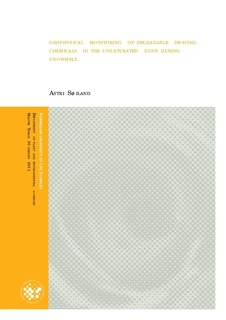| dc.contributor.author | Søiland, Astri | |
| dc.date.accessioned | 2011-10-14T11:07:20Z | |
| dc.date.available | 2011-10-14T11:07:20Z | |
| dc.date.copyright | 2011 | |
| dc.date.issued | 2011-10-14 | |
| dc.identifier.uri | http://hdl.handle.net/11250/189352 | |
| dc.description.abstract | This master thesis focuses on the use of cross-borehole electrical resistivity tomography (ERT) surveys as a monitoring method of the infiltration of snowmelt containing de-icing chemicals. Oslo Airport Gardermoen (OSL) is located on Norway’s largest rain fed aquifer. The winter conditions require the use of de-icing chemicals (propylene glycol, PG, and potassium formate, KFo) due to safe air traffic. The groundwater is protected by law against contamination and as the de-icing chemicals are spread to the side of the runways, OSL is dependent on the transport rate and degradation capacity of the unsaturated zone. ERT is currently being tested in field as a monitoring method for the infiltration of de-icing chemicals and their degradation in the unsaturated zone.
A tracer experiment was carried out at Moreppen which is a research station located outside the area of OSL. PG and KFo were applied on the snow cover prior to the snowmelt in 2010 at two separate walls (north and south wall) of a lysimeter trench together with an inactive tracer (Br-). The infiltration of chemicals and snowmelt at these two walls were monitored by cross-borehole ERT. Time-lapse inversions showing the difference in resistivity between the time of interest and a background dataset were compared, and the south wall infiltration monitored by the ERT was compared to extraction of soil water by the use of suction cups (Prenart Super Quartz) installed in the soil profile. Looking at time-lapse inversions, infiltration of melt water and conductive chemicals is clearly seen. The north wall showed greater depth of infiltration with higher reduction in resistivity compared to the south wall. This can be due to coarse layers of sediment at different depth in the two profiles slowing down the infiltration. PG applied to the south wall is not conductive and KFo is, explaining differences in reduction of resistivity. The infiltration depth suggested by the suction cups was shallower than shown by the ERT for the south wall indicating that either infiltrating water was transported deeper than Br- or that old water was pushed deeper by piston flow. Time-lapse inversions are shown here to be a good qualitative method to monitor infiltration of water and conductive chemicals at a scale of a few meters, such as in field experiments.
Individual inversions for the south and north wall of the separate datasets were temperature corrected. Electrical resistivity is temperature dependent and to be able to view changes due to solute and water content needs to be removed. ERT gives mainly qualitative inversion results and to obtain quantitative information in form of water content and saturation the inversions for the south wall were converted using petro-physical relationships and fitting parameters from soil at Moreppen. Yeh et al. (2002)’s formula for water content gave values within the expected range when comparing the values to previous water content measurements. Saturation calculated from Archie’s law seems to be limited by the uncertainty of estimated porosity as the porosity is likely changing through the profile and might give better results when looking at change in saturation when porosity can be assumed fixed. As translating ERT inversions to water content using the fitting parameters for the Moreppen soil has been shown here to be within a realistic range, the conversion has the potential to calculate the solute resistivity and change in solute over time if water content is known. Combining ERT with a method to measure water content (e.g. TDR) would allow the inversions, using these formulas, to be converted to solute which is of interest when monitoring contamination in the subsurface. Joint inversions with cross-borehole ground-penetrating radar (GPR) surveys will provide superior inversions. | en_US |
| dc.description.sponsorship | The SoilCAM project which is funded by the European Commission's 7th Framework Programme | en_US |
| dc.language.iso | eng | en_US |
| dc.publisher | Norwegian University of Life Sciences, Ås | |
| dc.subject | Electrical resistivity tomography | en_US |
| dc.subject | Snowmelt | en_US |
| dc.subject | De-icing chemicals | en_US |
| dc.subject | Lysimeter | en_US |
| dc.title | Geophysical monitoring of degradable di-icing chamicals in the unsaturated zone during snowmelt | en_US |
| dc.type | Master thesis | en_US |
| dc.subject.nsi | VDP::Mathematics and natural science: 400::Chemistry: 440 | en_US |
| dc.source.pagenumber | 68 | en_US |
